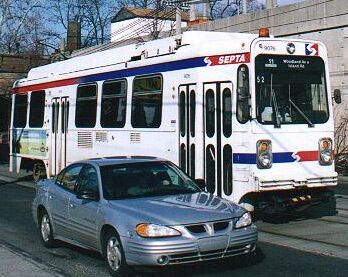
Light Rail Now/Light Rail Progress can be contacted at: Light Rail Now! |
In any city, light rail transit (LRT) has the potential to significantly increase the capacity of the public streets and roadways in which it operates. This is often not grasped by opponents and critics who resist reallocating traffic lane capacity, from being exclusively dedicated to motor vehicles, to either sharing the space with LRT or dedicating it exclusively to LRT. These opponents often include highway engineers, public works officials, local politicians, and, indeed, many ordinary motorists. But cities cannot keep "chasing" the rise in motor vehicle traffic with fruitless efforts to maintain roadway capacity. Traffic volumes – dependent mainly on private automobiles – are far outstripping street and road capacity, and the ability and resources of urban governments to provide that capacity.
It's essential for every citizen to understand that, while streetcars (or other forms of LRT) may "get in the way" of automobiles, they vastly increase the capacity of the street to move people – even when sharing the roadway lanes with mixed traffic. Most motorists do not realize that.
If we add a rail line to the center of the street, it may cut the carrying capacity of the street lane from 900 passengers per hour by auto to 750 as rail cars "hamper" auto movement. But if the rail line is justified (in terms of ridership, cost-effectiveness, net benefits, etc.), it may be moving 1,500, 2,500, or even more than 4,000 people per lane per peak hour. And keep in mind that streetcars can be operated in trains – typically, two to three cars in length. Buses, of course, could be used instead, but they will consume more auto space and, almost surely, move fewer transit riders. instead of 750 passengers remaining in automobiles per lane, the passenger flow will drop to 600 as more buses than rail cars are needed. Furthermore, buses, on average, will attract approximately thirty percent fewer riders than LRT because of the comparatively lower passenger-attraction characteristics of buses (see Transportation Research Board Report 1221). Thus, only 1,050, 1,750, or perhaps 2,800 passengers will be moved per lane per peak hour. LRT is far more likely to make the best and most efficient use of the street lane for the public at large. These characteristics are summarized in the following table: Peak Passenger Capacity per Lane per Hour
Certainly, any form of LRT will work better if it is not mixed with automobiles. But if there is no other route to follow, street or road lanes can and should be used. After all, virtually all cities have ubiquitous traffic, economic, safety, and pollution problems that need to be solved. Substantially increasing passenger-flow capacity through the introduction of attractive streetcar-type LRT can contribute to the solution. Photo credits: Rob's Transit Trips (Philadelphia LRV); M. Kavanaugh (Portland streetcar). Updated 2003/04/24 | ||||||||||||||||